Flies
The word 'fly' has been applied to many insects over time, but true flies are members of the order Diptera. This is a remarkably large and varied group of insects which contains a number of beneficial species, as well as a number of species that can be harmful to mankind. Within this group, you will find mosquitoes, crane flies, hover flies, robber flies, bot flies, house flies and many more. Of all the groups of insects, this group holds perhaps the most concern for us - mosquitoes carry a number of diseases that can be harmful to people, as do a number of other fly groups. But there are some attractive species in this group, especially among the hover flies and robber flies - many of them being bee or wasp mimics.
There are so many species in this group, and so many that are very difficult to identify to species without the use of a hand lens or even a microscope, that many of the groups in this guide are only identified to the genus level. But that's a good start! Important features for identifying flies are the same as for most insect groups and include details of the head (especially the eyes, hairs on the face and antennae), wing venation and details of the legs. One thing to remember that helps to identify flies from other groups (since many of them mimic other groups) is that flies have only one pair of developed wings, with the other pair typically being reduced to small stubs. Most other insects show two pairs of well-developed wings - useful when trying to sort out the bee and wasp mimics.
(For a list of all fly species on the site, click here)
Use the photos below to narrow your search to a group of flies, then click on the picture to go to the next stage.
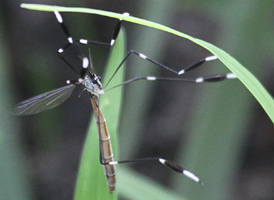 |
Phantom Crane Flies
An interesting small group of long-legged flies that can be found close to the ground beside wet streams and ditches. They drift on the breeze with their striped legs splayed out to catch the wind and easily slip out of view among a background of tangled vegetation - hence their English name.
|
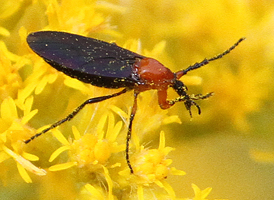 |
March Flies
A group of flies which typically first appear on the wing in March (hence the name) but adults of some species may be found throughout summer. Usually black or black and orange in color with bulbous abdomens and strangely small heads. Most often found feeding at flowers in gardens or open field habitats and may occur in large numbers.
|
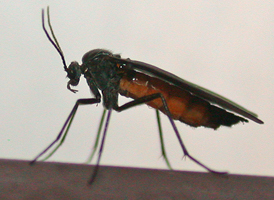 |
Dark-winged Fungus Gnats
Very common flies that are easily overlooked due to their tiny size. Some species are all black while others are black and red. They often congregate around rotting vegetation on compost heaps and similar places.
|
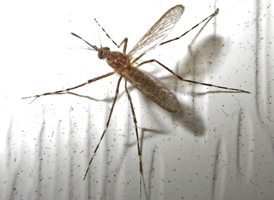 |
Mosquitoes
Due to their abundance and their habit of being vectors for a number of nasty diseases and infections, these insects are known all too well. Mosquitoes are small to very small flies with relatively long, slender legs and a long - and usually easily visible - stylus. They are abundant almost everywhere, but particularly in freshwater wetland areas and will come readily to light in the evening.
|
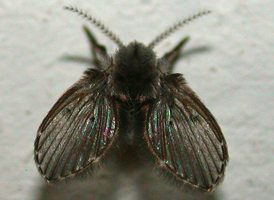 |
Filter Flies
Small, dark flies with furry wings that are most often found hanging out around plug holes and drain holes in sinks, showers and wash basins. They are silent fliers but usually don't move far and can be quite approachable.
|
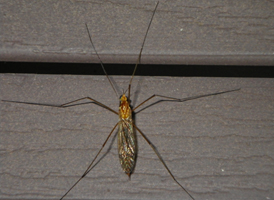 |
Crane Flies
Also well-known as 'daddy-long-legs', these are easily recognized flies due to their long, gangly legs, narrow, long wings and seemingly bumbling behavior. They typically fly low to the ground but will also enter houses when attracted to lights.
|
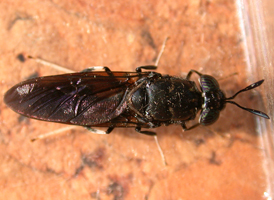 |
Soldier Flies
Medium-sized flies that resemble the more familiar hover flies, but are much less common. Most species are wasp mimics and often have dark wings and yellowish markings. The relatively long, stout antennae help to separate them from hover flies.
|
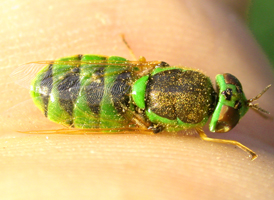 |
Soldier Flies
Medium-sized flies that resemble the more familiar hover flies, but are much less common. Most species are wasp mimics and often have dark wings and yellowish markings. The relatively long, stout antennae help to separate them from hover flies.
|
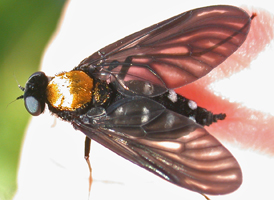 |
Snipe Flies
Medium-sized flies that can be quite conspicuous in grassy areas near wetlands or along woodland edge. Typically have delta-shaped wings and relatively long legs. Bodies are rather chunky with tapered abdomens. Species may be dull brownish or black while others have white or yellow patches or spots.
|
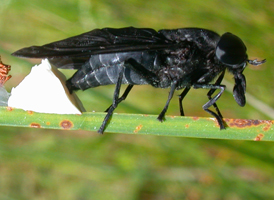 |
Tabanid Flies
A group of generally dark brown or blackish flies with large eyes that are often remarkably colored or patterned in red or green. Some species have patterned wings. This group includes such infamous species as horse flies, deer flies and greenhead flies.
|
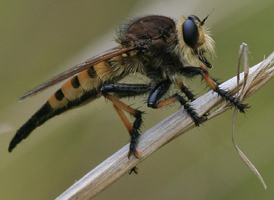 |
Robber Flies
Often large and sometimes fearsome-looking, robber flies are harmless to humans but are voracious feeders on other insects. Many species resemble bees or wasps but typically have relatively long and narrow abdomens. Usually very hairy-looking with brownish or yellowish hairs. Abdomen blue-gray in some species.
|
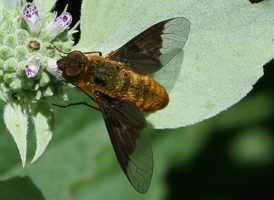 |
Bee Flies
This is a group of flies that is made up of a number of species that are clearly mimics of bees. They typically have very hairy, stout bodies and often have dark patterning on the wings. Some species have long proboscises which are carried straight out in front of the head in flight. Some species are on the wing in early spring while others are around later in the year.
|
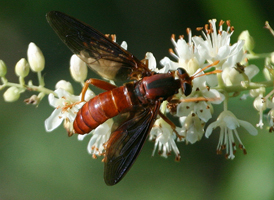 |
Mydas Flies
Although widespread and not uncommon, Mydas flies are easily overlooked as they mimic wasps - particularly the spider-hunting species. Adults are relatively short-lived and are best looked for around flowers during the hot summer months. Species may be overall black or reddish brown and often with yellow on the legs and/or antennae.
|
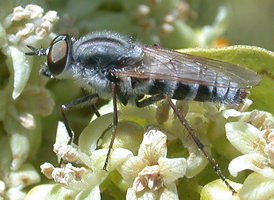 |
Stiletto Flies
Uncommon flies with slender abdomens that resemble robber flies but have more slender legs and are generally uncommon. Usually rather plain brownish or grayish in color.
|
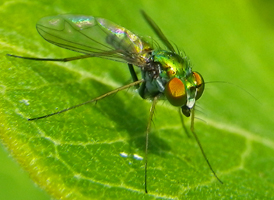 |
Long-legged Flies
An interesting group of flies which usually have metallic bodies and long, slender, stilt-like legs. They are most often found scuttling around on leaves in shrubby or wooded areas.
|
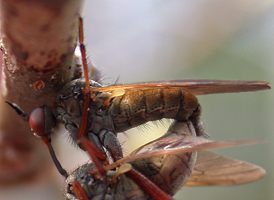 |
Dance Flies
A strange group of insects with often long and stout proboscises and tapered bodies. Many have peculiar courtship displays and present partners with food items - suspect that you have one of these if you find a pair of flies hanging under a branch with their lunch!
|
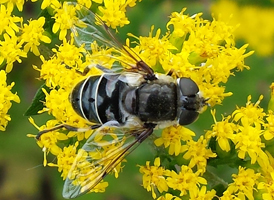 |
Hover Flies
Common and widespread and often abundant around open, flowery places in late summer. Most species are bee and wasp mimics, having dark bodies with stripes of yellow or white. Size and shape is very variable, from small, slender species to large, chunky-bodied ones.
|
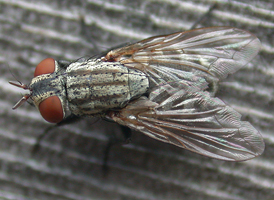 |
Typical Flies
A group of mostly dark gray or blackish flies, but some are also metallic blue or green. Abundant and familiar flies with deltoid wings, chunky bodies and relatively large heads.
|
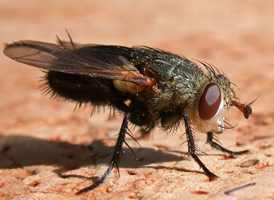 |
Tachinid Flies
Stout, usually dark-colored flies that often have a few stout bristles scattered over the abdomen. Many species have a contrasting white face. Widespread but usually seen singly, often feeding at flowers.
|
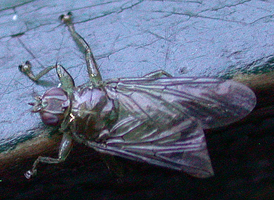 |
Flat Flies
Also known as louse flies, this group of insects is seldom seen by most people as they live as external parasites of birds. They may be found scuttling crab-like between the feathers of live birds, but otherwise can pass unnoticed. May be black, brown or greenish in color and with a very flattened profile.
|
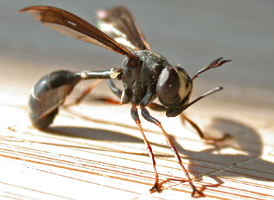 |
Thick-headed Flies
A group of peculiar-looking wasp-mimics, thick-headed flies usually have a heavy-headed look and large eyes. Most species have a wasp-like look with some even having a narrow-waisted look to them. Adults are most often found around flowers.
|
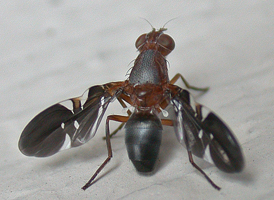 |
Picture-winged Flies
Small, dark-bodied flies that are recognizeable not only by their patterned wings, but by the way they wave the wings like little flags. Sometimes visit flowers and come to light, but may also be found on fences or walls.
|